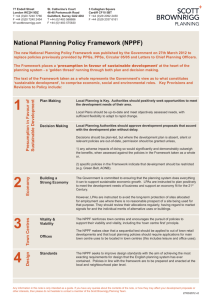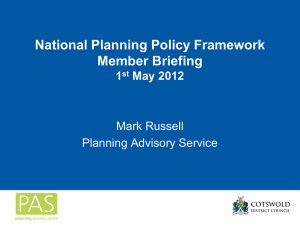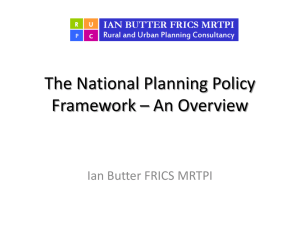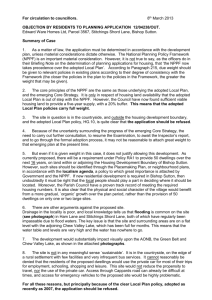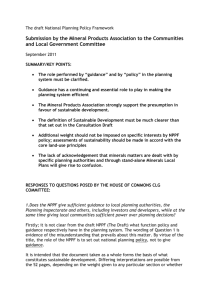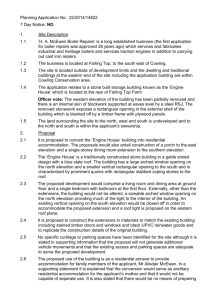Document 12926906
advertisement
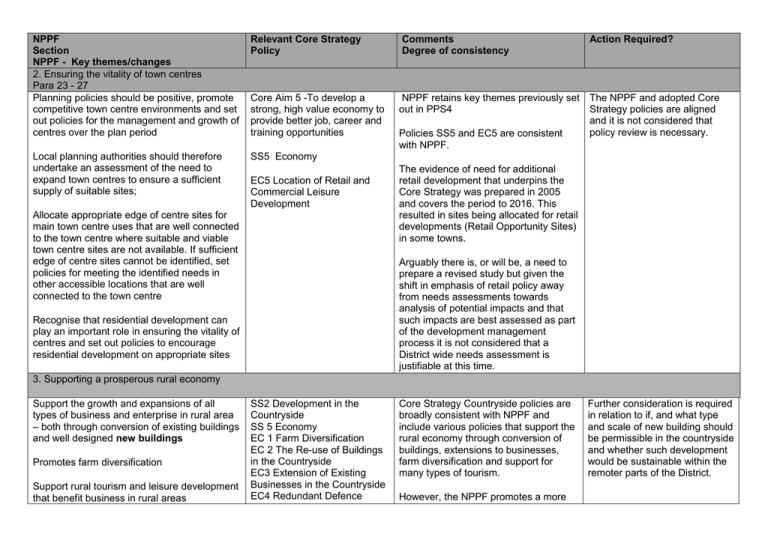
NPPF Section NPPF - Key themes/changes 2. Ensuring the vitality of town centres Para 23 - 27 Planning policies should be positive, promote competitive town centre environments and set out policies for the management and growth of centres over the plan period Relevant Core Strategy Policy Comments Degree of consistency Core Aim 5 -To develop a strong, high value economy to provide better job, career and training opportunities NPPF retains key themes previously set The NPPF and adopted Core out in PPS4 Strategy policies are aligned and it is not considered that policy review is necessary. Policies SS5 and EC5 are consistent with NPPF. Local planning authorities should therefore undertake an assessment of the need to expand town centres to ensure a sufficient supply of suitable sites; SS5 Economy EC5 Location of Retail and Commercial Leisure Development Allocate appropriate edge of centre sites for main town centre uses that are well connected to the town centre where suitable and viable town centre sites are not available. If sufficient edge of centre sites cannot be identified, set policies for meeting the identified needs in other accessible locations that are well connected to the town centre Action Required? The evidence of need for additional retail development that underpins the Core Strategy was prepared in 2005 and covers the period to 2016. This resulted in sites being allocated for retail developments (Retail Opportunity Sites) in some towns. Arguably there is, or will be, a need to prepare a revised study but given the shift in emphasis of retail policy away from needs assessments towards analysis of potential impacts and that such impacts are best assessed as part of the development management process it is not considered that a District wide needs assessment is justifiable at this time. Recognise that residential development can play an important role in ensuring the vitality of centres and set out policies to encourage residential development on appropriate sites 3. Supporting a prosperous rural economy Support the growth and expansions of all types of business and enterprise in rural area – both through conversion of existing buildings and well designed new buildings Promotes farm diversification Support rural tourism and leisure development that benefit business in rural areas SS2 Development in the Countryside SS 5 Economy EC 1 Farm Diversification EC 2 The Re-use of Buildings in the Countryside EC3 Extension of Existing Businesses in the Countryside EC4 Redundant Defence Core Strategy Countryside policies are broadly consistent with NPPF and include various policies that support the rural economy through conversion of buildings, extensions to businesses, farm diversification and support for many types of tourism. However, the NPPF promotes a more Further consideration is required in relation to if, and what type and scale of new building should be permissible in the countryside and whether such development would be sustainable within the remoter parts of the District. Establishments EC5 location of retail and commercial Leisure Development EC7 Location of New Tourist Development CT3 Provision and Retention of Local Facilities and Services permissive approach and appears to allow for new build employment generating proposals. Transport policies have an important role to play in facilitating sustainable development but also in contributing to wider sustainability and health objectives. Core Aim 2 - To Provide for sustainable development and mitigate and adapt to climate change The Core Strategy Policies are consistent with NPPF. The transport system needs to be balanced in favour of sustainable transport modes, giving people a real choice about how they travel. Core Aim 6 – To improve access for all to jobs, services, leisure and cultural activities Encouragement should be given to solutions which support reductions in greenhouse gas emissions and reduce congestion. In preparing Local Plans, local planning authorities should therefore support a pattern of development which, where reasonable to do so, facilitates the use of sustainable modes of transport. SS1 Spatial Strategy for North Norfolk Promote the retention and development of local services and community facilities 4 Promoting sustainable transport CT5 The Transport Impact of new Development CT6 Parking Provision CT 7 Safeguarding Land for Plans and decisions should ensure Sustainable Transport Uses developments that generate significant movement are located where the need to travel will be minimised and the use of sustainable transport modes can be maximised. However this needs to take account of policies set out elsewhere in this Framework, particularly in rural areas. 5. Supporting high quality communications infrastructure Para 42 - 46 The NPPF and adopted Core Strategy policies are aligned and it is not considered that policy review is necessary In preparing Local Plans, local planning authorities should support the expansion of electronic communications networks, including telecommunications and high speed broadband CT 4 Telecommunications 6. Delivering a wide choice of high quality homes Para 47 - 55 To boost significantly the supply of Core Aim 1 – To support the housing housing needs of the whole community Policy SS3 Housing i. Identify and update annually a supply of specific deliverable sites sufficient to Policy HO1 Dwelling Mix and Type provide five years worth ii. of housing + additional buffer of 5% Policy HO2 Provision of Affordable Housing Policy HO3 Affordable iii. Set out their own approach to housing Housing in the Countryside density to reflect local circumstances. Policy HO4 Sites for Gypsies and Travellers and for iv. Plan for a mix of housing based on Travelling Show people current and future demographic trends, Policy HO5 Agricultural, market trends and the needs of Forestry and Other different groups in the community Occupational Dwellings in the Countryside v. Set policies for meeting affordable Policy HO7 Making the Most housing need on site, unless off-site Efficient Use of Land (Housing provision or a financial contribution of Density) broadly equivalent value can be Policy HO9 Conversion and robustly justified. Such policies should Re-use of Rural Buildings as be sufficiently flexible to take account Dwellings of changing market conditions over time. vi. Normally approve planning applications for change to residential use and any associated development from commercial buildings (currently in the B use classes) where there is an identified need for additional housing in CT 4 is consistent with NPPF There is no specific reference in the CS to promoting high speed broadband but given this is a national objective there is no need to include this within the Council’s Plan. Overall the Housing Strategy is consistent with the NPPF but at a detailed level there are considered to be some issues which require further consideration For example Policy HO1 sets out the approach to housing mix but makes no specific reference to specialist housing for the elderly. Policy HO2 – Affordable housing – The NPPF places a greater emphasis on development viability and requires that authorities ensure viable developments with a reasonable return for both land owners and developers. The Councils adopted policies incorporate a viability test Policy HO7 – Sets local density targets. For the towns this is currently a min 40dph. These targets were included in the Core Strategy to reflect national requirements at the time. The NPPF and adopted Core Strategy policies are aligned and it is not considered that policy review is necessary Further consideration is necessary. that area, provided that there are not strong economic reasons why such development would be inappropriate. vii. Local planning authorities should consider the case for setting out policies to resist inappropriate development of residential gardens, for example where development would cause harm to the local area. viii. In rural areas local planning authorities should plan housing development to reflect local needs, particularly for affordable housing, including through rural exception sites. Local planning authorities should in particular consider whether allowing some market housing would facilitate the provision of significant additional affordable housing to meet local needs. ix. Local planning authorities should avoid new isolated homes in the countryside unless there are special circumstances such as: where the development would re-use redundant or disused buildings and lead to an enhancement to the immediate setting the exceptional quality or innovative nature of the design of the dwelling. 7 Requiring good design Plan positively for the achievement of high quality and inclusive design for all development, including individual buildings, public and private spaces and wider are HO3 - Rural Exceptions policy – should be extended to allow an element of market housing where it would facilitate the provision of significant additional affordable housing to meet local needs HO9 - Allows the conversion of rural buildings to dwellings where a) they are located in designated locations, or b) the buildings are of particular heritage value. NPPF allows the residential conversion of redundant or disused buildings in the countryside where it would lead to an enhancement of the immediate setting. Core Aim 3 To protect and built and natural environment and local distinctive identity of North Norfolk, and enable Core Strategy policies consistent with NPPF HO3 – Broadly consistent but should allow for element of market housing where it would facilitate the provision of significant additional affordable housing to meet local needs. NPPF Para. 54 considered a material consideration to be afforded significant weight HO9 – inconsistent with Para 55 Requires further consideration. The NPPF and adopted Core Strategy policies are aligned and it is not considered that policy review is necessary development schemes people’s enjoyment of this resource EN4 Design Design Guide SPD 8. Promoting healthy communities Para 69 - 78 The planning system can play an important role in facilitating social interaction and creating healthy, inclusive communities Core Aim 6 – To improve access to jobs, leisure and cultural facilities The NPPF and adopted Core Strategy policies are aligned and it is not considered that policy review is necessary To deliver the social, recreational and cultural facilities and services the community needs, planning policies and decisions should: plan positively for the provision and use of shared space, community facilities and other local services to enhance the sustainability of communities and residential environments; 9. Protecting Green Belt land Para. 79 - 92 Not applicable 10 Meeting the challenge of climate change, flooding and coastal change Para. 93 - 108 LPA should adopt proactive strategies to Core Aim 4 – To mitigate and mitigate and adapt to climate change, taking adapt to impacts of coastal full account of flood risk, coast change and erosion and flooding water supply To help increase the use and supply of EN6 –Sustainable construction renewable and low carbon energy, and Energy efficiency. local planning authorities should recognise the responsibility on all EN7 – Renewable Energy communities to contribute to energy generation from renewable or low EN10,11, and 12 – Flood risk The NPPF and adopted Core Strategy policies are aligned and it is not considered that policy review is necessary carbon sources. They should consider identifying suitable areas for renewable and low carbon energy sources, and supporting infrastructure, where this would help secure the development of such sources; and Coastal erosion 11. Conserving and enhancing the natural environment Para. 109 - 125 Planning policies and decisions should Core Aim 3 To protect and encourage the effective use of land by rebuilt and natural environment using land that has been previously developed and local distinctive identity of (brownfield land) North Norfolk, and enable people’s enjoyment of this resource Local planning authorities should take into account the economic and other benefits of the best and most versatile agricultural land. Local planning authorities should set criteria based policies against which proposals for any development on or affecting protected wildlife or geodiversity sites or landscape areas will be judged. Distinctions should be made between the hierarchy of international, national and locally designated sites EN9 Biodiversity and Geology 12 Conserving and enhancing the historic environment Para 126 - 141 Heritage assets should be conserved in a Core Aim 3 To protect and manner appropriate to their significance. built and natural environment and local distinctive identity of North Norfolk, and enable people’s enjoyment of this resource EN8 – Protecting and enhancing the historic environment 13 Facilitating the sustainable use of minerals Policy EN9 currently does not distinguish between international, national and locally designated sites – all are protected from direct or indirect adverse impacts Further consideration is necessary Core Strategy policies consistent with NPPF The NPPF and adopted Core Strategy policies are aligned and it is not considered that policy review is necessary Para 142 - 149 Not applicable
